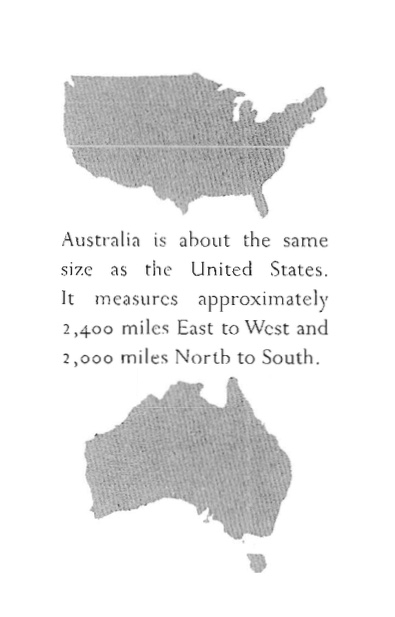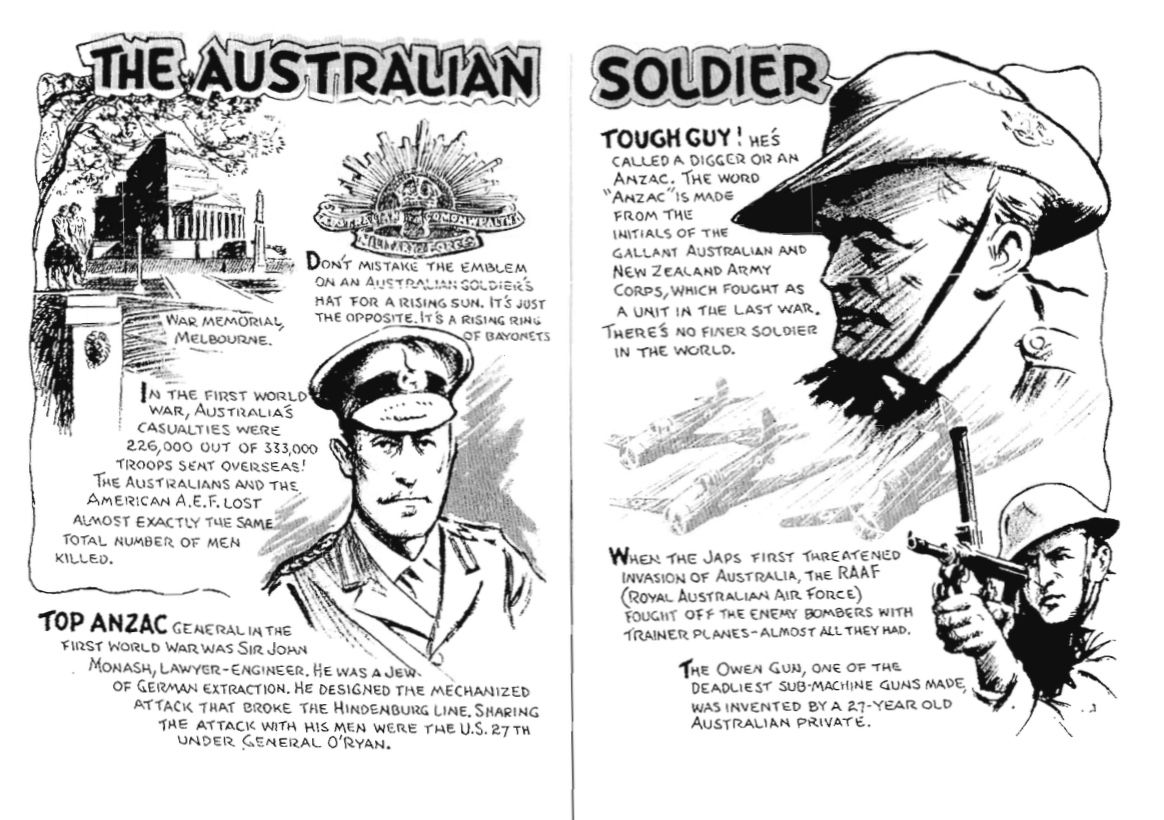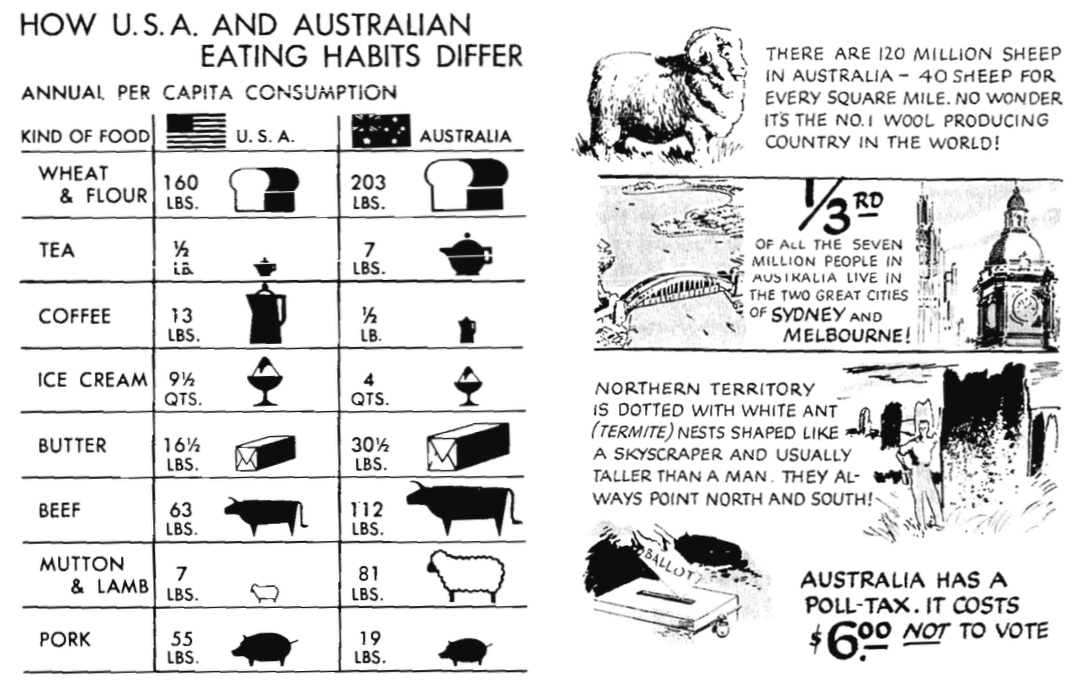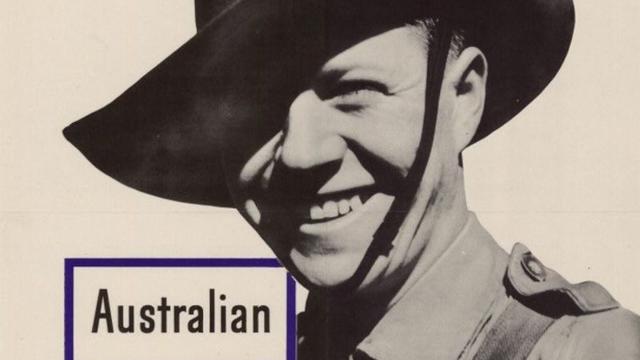Americans and Australians share so much when it comes to a common language, values of liberal democracy and certain similarities of history. But the Yanks and the Aussies are just different enough that they often look at each other sideways — whether it’s disagreements over snacks or confusion with slang. Which is precisely why the US military published a booklet during World War II in order to bridge the cultural divide.
US wartime poster that reads “This man is your FRIEND, he fights for FREEDOM” and showing an Australian service member (UNT Libraries)
With President Trump bent on destroying the historic relationship between the two countries, it seems like a perfect time to look at an artefact of WWII that was intended to bring Americans and Australians together. Published in 1942, the 54 page book “Instructions for American Servicemen in Australia” gave Americans information on everything from statistics on food (the average Australian ate twice as much beef as Americans at the time) to the kind of slang they were likely to hear (“bonzer”, for instance, was a word for “great or super”).
But overall, the main message of the booklet was that Australians were some of America’s greatest allies in the South Pacific. And whatever minor cultural differences there were, Americans should be proud to have such amazing people on their side.
“All Americans who’ve had anything to do with them say they’re among the friendliest guys in the world — and fine physical specimens of fighting men,” the pamphlet bragged. My own grandfather, who served in the US Navy during WWII and whose ship helped transport Australians from Japanese prison camps back to Australia, has said as much about Australian servicemen of the time.

Of course, some of the references in the pamphlet are rather offensive, even for the period. The book refers to the “70,000 or so primitive ‘Abos’” in the country, a highly offensive term for Aboriginal Australians. And there’s no shortage of racism against the Japanese (widely referred to as “Japs” in the US) who were, of course, the adversary in the Pacific theatre.
But the book remains an interesting document that sought to establish a military and cultural alliance that has been vital to both countries ever since. With a single phone call over the weekend, President Trump seems prepared to destroy that alliance either through ignorance or malice. Either way, Trump seems poised to weaken the ties between two countries that have their roots in the Second World War.
“Do you believe it? The Obama Administration agreed to take thousands of illegal immigrants from Australia. Why? I will study this dumb deal!” President Trump tweeted out on Thursday afternoon. Trump was responding to an article that had just been posted in the Washington Post detailing the many ways that Trump has bullied Australian Prime Minister Malcolm Turnbull in a call over the weekend. Trump reportedly told Turnbull that the deal signed by the Obama administration to resettle refugees currently held by Australia in the United States might not be honoured. “This is the worst deal ever,” Trump told Turnbull before cutting their call short — something that some news outlets have referred to as Trump hanging up on Turnbull.
But when the US-Australia military relationship was relatively new, there was a concerted effort by the American military to make sure that their troops understood their allies. And with any luck Trump realises how important that relationship still is.
After the dust-up about what was or was not said in the call with Trump and Turnbull, I started thinking about this booklet. I have a pdf stored on a hard drive but forget where I found it online. My Google searches brought me no closer to figuring out who originally posted it. I’ve uploaded it below in its entirety. If you were the original uploader, please let me know so I can give you credit.

A two-page spread form the 1942 booklet Instructions for American Servicemen in Australia, given to US servicemembers in the South Pacific during WWII
Naturally, the booklet starts off by establishing a common bond and a common enemy. Well, two common enemies, obviously. Hitler and “the Japs”. I told you this was going to be uncomfortable:
YOU and your outfit have been ordered to Australia as a part of a world-wide offensive against Hitler and the Japs — a drive that will end in Tokyo and Berlin.
You’re going to meet a people who like Americans and whom you will like. The Australians have much in common with us: they’re a pioneer people; they believe in personal freedom; they love sports; and they’re out to lick the Axis all the way. But there are a lot of differences too — their ways of living and thinking on all sorts of things — like tea, central heating, the best way to spend Sunday, or saluting officers and such. You’ll find out about all those, but the main point is they like us, and we like them.
The pamphlet included maps like the one below, putting travel times into context. It notes that the “normal” shipping time from the west coast of the US to Australia is roughly three to four weeks. But it notes that planes, still in their relative infancy for commercial travel, were quickly changing all that.

A map showing Australia’s geographic relation to the world with various travel times as it appeared in the 1942 booklet, Instructions for American Servicemen in Australia
From the booklet:
Maybe there are fewer people in Australia than there are in New York City, but their soldiers, in this war and the last, have built up a great fighting record. For three years now, they have fought on nearly every battle front of the war; they have suffered heavy losses in Crete, Libya, Greece, and Malaya; and they’re still in there pitching. The Australians need our help in winning this war, of course, but we need theirs just as much.
The booklet talks about the shared history of the United States and Australia, mentioning that convicts were sent to the island-nation because Britain could no longer send them to the US after the Revolutionary War. But it’s interesting to see that the pamphlet goes so far as to hint that the Commonwealth of Australia might soon become a republic, independent of the UK.
It’s still a perennial issue in Australia today, of course, with bipartisan support but strangely little traction. As recently as last month Prime Minister Turnbull brought up the issue and was accused of simply trying to distract from domestic problems like rising housing costs.
From the booklet:
They resent being called a colony and think of themselves as a great nation on their own hook, which they are. And it’s natural that they should find themselves drawn closer and closer to Americans because of the many things we have in common. They look at the swift development that has made the United States a great power in a few generations, and compare our growth with theirs. Nearly 40 years ago, an Australian statesman said of the United States: “What we are, you were. What you are we will some day be.”
The booklet also sought to give a sense of how much Australians value friendship or a tradition of “mateship” as they’d call it today. And you shouldn’t be offended if someone calls you a bastard (spelled “barstud” in the booklet for the pronunciation).
You’ll find the Australians an outdoors kind of people, breezy and very democratic. They haven’t much respect for stuffed shirts, their own or anyone else’s. They’re a generation closer to their pioneer ancestors than we are to ours, so it’s natural that they should have a lively sense of independence and “rugged individualism”. But they have, too, a strong sense of cooperation. The worst thing an Australian can say about anyone is: “He let his cobbers (pals) down.” A man can be a “dag” (a cutup) or “rough as bags” (a tough guy), but it he sticks with the mob, he’s all right.
If an Australian ever says to you that you are “game as Ned Kelly”, you should feel honored. It’s one of the best things he can say about you. It means that you have, the sort of guts he admires, and that there’s something about you that reminds him of Ned Kelly. Kelly was a bushranger (a backwoods highwayman) and not a very good citizen, but he had a lot of courage that makes Australians talk about him as we used to talk about Jesse James or Billy the Kid.
Of course, the best thing any Australian can say about you is that you’re a “bloody fine barstud”.
The booklet gives an interesting little peek at the soft diplomacy of movies, something we’ve definitely explored here before. And the booklet warns that while Australians might know some American slang, it might take a while for American GIs to pick up on Australian words.
Thanks to our movies, the average Australian has some working knowledge of our slang, but it will take you a while to get on to theirs. To them a “light guy” is a “fair dinkum”; a hard worker is a “grafter” and “to feel crook” means to feel lousy; while “beaut” means swell. Australian slang is so colourful, and confusing, that a whole chapter is devoted to it at the end of this book.
The booklet moves from language to the Australian love of song. And boy do they love to sing. How much do they love to sing? The booklet calls one song that’s making its way through the ether “an epidemic”. The booklet spends a few pages printing the entire lyrics to “Waltzing Matilda”.
Australians, like Russians, are natural group singers. It’s one of the great differences you’ll notice between American camps and Australian – the singing.
Aussie soldiers and girls know every American popular song from Stephen Foster’s “My Old Kentucky Home” to the latest tune of a year or so ago. The very latest jive stuff may confuse them a bit, but they’re catching on after listening to American regimental swing bands. The hit song in Australia today is “Bless Them All”, which has become almost a national epidemic — the Aussies sing it with curious variations from the original lyrics.
The booklet also has illustrations with little fun facts about the country, including one about how the country has a kind of reverse poll tax. Which is to say, they have compulsory voting, which is still true today. Imagine that! A country that wants all of its citizens to vote!

A chart showing the average food consumption in the United States versus Australia in 1942 (left) and illustrations with fun facts about Australia, including compulsory voting (right)
The booklet describes Australians as “meat and potatoes guys” who aren’t really into wussy stuff like green vegetables.
Australians are great meat eaters — they eat many times as much beef, mutton, and lamb as we do — and a lot more flour, butter, and tea. But they don’t go in for green vegetables and salads and fruits as much as Americans. Some of the best fruits in the world are grown along the tropical coasts of Queensland, but the Australian, nevertheless, is strictly a “meat and potatoes guy”.
The booklet also explains that the snacks you’ll find in Australian might be more of a Chinese variety, though you’ll definitely find people catching up to the hot dog and hamburger craze down under.
Meat pies are the Australian version of the hot dog, and in Melbourne, the substitute for a hamburger is a “dim sin”, chopped meat rolled in cabbage leaves which you order “to take out” in Chinese restaurants. But because of the demand, hot dog and hamburger stands are springing up in large numbers. So you’ll probably see signs like this when you get around the country a bit: “500 yards ahead. Digger Danny’s Toasted Dachshunds.” But you won’t find drug stores selling sodas or banana splits.
So what about a drink? They’re definitely around, but hard liquor is hard to come by so you’ll probably be sticking to beer and wine.
Drinking in Australia is usually confined to hotel bars, during the few hours they’re allowed to open – they close at 6 p.m. in most places. The main drink is beer — stronger than ours and not as cold. Hard liquor is fairly expensive and much less commonly drunk than in America. They also make some good light wines.
Not up for booze? Then you better get ready for some tea, my friend, because the Australians drink a lot of it.
But the national drink is still tea, which you will .find is a good drink when you get used to it. Along the roads you’ll see “hot water” signs displayed — Australian motorists take along their own tea and for a few pence, from the roadside stands, they can get hot water and a small tin can (billy can) in which they brew their tea. But since the war began, there isn’t any motoring.
Interested in sports? Well, Aussies love sports. And they also apparently love shouting “wake up melon head” at referees.
As an outdoor people, the Australians go in for a wide variety of active sports — surf- bathing, cricket, rugby, football, golf, and tennis. The national game is cricket and the periodic “test matches” with England are like our World Series. Cricket isn’t a very lively game to watch, but it’s difficult to play well. Not much cricket is being played nowadays.
The Australians have another national game called Australian Rules Football, which is rough, tough, and exciting. There are a lot of rules — the referee carries a rule book the size of an ordinary Webster’s Dictionary. Unlike cricket, which is a polite game, Australian Rules Football creates a desire on the part of the crowd to tear someone apart, usually the referee — some parks have runways covered over, so the referee can escape more or less intact, after the game is over. The crowd is apt to yell “Wake up melon head” or some such pleasantry at the umpire, but they don’t think it good sportsmanship to heckle the teams. Australian soldiers play it at every chance. In one camp the boys used Bren gun carriers to clear a field to play on and that afternoon 500 out of an outfit of 700 got into a game.
And Australians love a good horse race. The only difference between American and Australian horse racing is that they run in the opposite direction on the track.
But above all the Australians are the No. 1 racing fans in the world. Most cities and towns of any size have race tracks and some like Perth have trotting tracks which used to be lighted up for night racing before the “brown- out” (the Australian version of the black-out). The big event of the year is the running of the Melbourne Cup, established in 1861, 14 years before our Kentucky Derby. It’s a legal holiday in Melbourne the day the race is run. There’s one main difference between Australian racing and ours. Their horses run clockwise.
In fact, Australians love anything they can gamble on:
As one newspaper correspondent says, the Americans and the Australians are “two of the gamblingest people on the face of the earth”.
It’s been said of the Australians that if a couple of them in a bar haven’t anything else to bet on, they will lay odds on which of two flies will rise first from the bar, or which raindrop will get to the bottom of the window first. If an American happened to be there, he’d probably be making book.
The booklet talks a bit about the kind of political system that Australia has, calling it arguably the most democratic in the world. The booklet doesn’t mention anything about the White Australia Policy or the lack of recognition for Aboriginal Australians in the Constitution, but in fairness, those are the kinds of things (like Jim Crow laws) that likely wouldn’t have been mentioned in an Australian-made publication about the United States in the 1940s.
For more about how black US service members were treated in Australia, you can read this article I wrote from 2015.
In many respects Australia is the most democratic government in the world. Certainly in the short space of 150 years, it has made many notable contributions to social legislation in which it has pioneered. It developed the famous Australian Ballot; it set up one of the first central banks in the world. Incidentally, much of the credit for its founding — it’s called the Commonwealth Bank — goes to an American immigrant to Australia, King O’Malley, a bearded Californian who became one of the nation’s political leaders early in this century. Australians like him for his impatience with ceremony and remember him for his phrase about stuffed-shirt officials – “gilt-spurred roosters”. Also the nation pioneered in social security and workmen’s compensation laws and developed a unique and workable system of industrial arbitration courts which have helped to reduce strikes and disputes to a minimum.
Before ending with a glossary of Australian slang, the booklet references a few small differences in the Imperial measurement system (Australia, like the rest of the world, is metric here in 2017) and makes note of how to read the money.

A two-page spread form the 1942 booklet Instructions for American Servicemen in Australia, given to US servicemembers in the South Pacific during WWII
And, of course, it gives one last shout-out to how committed Australians are about the war effort.
“FIGHT, work, or perish” — that’s the slogan you’ll see all over Australia, and it means just what it says.
Australia’s doing a lot more than just providing the Allied nations with fine fighting men; she’s equipping her own troops and those of Britain and the United States with a great variety of weapons and supplies — tanks, some planes, torpedo bombers, gun carriers, shells, range finders, as well as ships and food and clothing.
Australia’s swing-over to high-geared war production is an amazing example of careful, intelligent planning, technical ingenuity and a ruthless cutting down of civilian consumer goods. In a good many lines of production, Australia had to start from scratch. In 1938 there wasn’t any aircraft industry, but by 1941 Australia had produced a thousand planes and production is being stepped up constantly. The Australians are proud of the Bristol Beaufort torpedo bomber – as proud as we are of our Flying Fortresses. And they’re even prouder of the new Owen tommy-gun which they consider is simpler and cheaper to make than any other submachine gun in the world — and is particularly effective under tough conditions. It was invented by a 27-year-old mortar mixer from Wollongong, New South Wales, who was a private in the Australian army.
You won’t have any trouble finding out that everyone in Australia is in the war all down the line. There aren’t many cars on the streets; taxis are hard to get; streetlights have been turned off to save power; and the Prime Minister recently announced that all nonessential industries would be shut down for the duration. Clothes and food have been severely rationed and wages, prices and profits have been frozen for the duration. So life for the Australians isn’t as free and easy as it was, but they’re out to win the war and to hell with comforts.
[…]
There isn’t any need for a lot of do’s and don’t’s for Americans in Australia. Common sense and good will go a long way there as they do anywhere else. As a matter of fact, the Australians, especially the girls, are a bit amazed at the politeness of American soldiers.
And they say that when an American gets on a friendly footing with an Australian family lie’s usually found in the kitchen, teaching the Mrs. how to make coffee, or washing the dishes.
American troops have been welcomed in Australia with a good deal of warmth and a feeling of close kinship. The feeling; that we and the Australians are “cobbers” means a fast finish for Mr. Jap.
You can find the complete booklet uploaded below. And hopefully President Trump takes a glance at it. He might learn a thing or two about how valuable America’s relationship with Australia is, if only for selfish military reasons. And military aside, Australians are a pretty nice people. I even married one.
